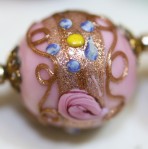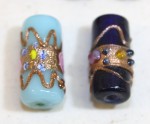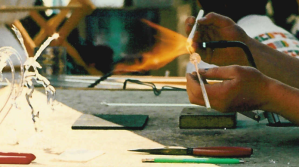 |
| Venetian Glass Beads |
I recently received a collection of beautiful old glass beads from an estate with instructions to sell them, and the inquiry into their history has been a fascinating journey for me. It seems the acquisition of them involved a journey as well, for the original owner toured the globe between the two world wars, and ended up, among other places, in the beautiful city of Venice.
What this jewelry-loving traveler acquired in Venice–or probably more likely, after a visit to the island of Murano, where glass-makers were sent in the 13th century so as not to imperil Venice with their hazardous furnaces and open flames–were several strands of a specific type of handmade glass bead known as
fiorato, or flowered. I have a feeling these lovely strands may have been purchased as potential gifts that happily ended up after all in her own jewel-box for 50 years. This is the kind of jewelry that becomes an irresistible commodity for tourists– so abundant and affordable when visiting the place of manufacture, and memorably exotic when returned home. Why not buy extras, just in case? There is hardly a better way to evoke the memory of a time and place than a piece or two of jewelry.

Fiorato beads get their start on a copper wire, which forms the hole when finished, by winding the hot colored glass around it into a fairly good sized ball. The centuries old process is called in Italian
perle `a lume–we call it lampwork or lampwound. For fiorato, the opaque bead is then decorated according to a theme involving glitter, squiggles and rosebuds. There are as many variations, apparently, as there are bead-makers, or moods of bead-makers, but the basic idea is the same. First, the dazzling glitter effect is applied. The glitter is actually a specific type of glass known as
avventurina or aventurine (not to be confused with the natural quartz of similar name), derived from the Italian word
a ventura, “by chance”. This transparent glass infused with copper filings causes an eye-catching gold-like glint when overlaid onto the surface of a bead, and it is characteristic of many exquisite Venetian beads. (Apocryphally, aventurine glass was discovered accidentally in a Murano workshop in the 1600s, and for many years was a closely guarded secret.) The next decoration applied are the various squiggles, known as a “trailing pattern”, which are narrow strands of glass “trailed” in loops or zigzags around the bead. The more there are, the more likely it is the beads are old, as this adds significant time to the manufacture. Finally, more or less carefully, the floral details are applied: the rosebuds usually in pink, and the forget-me-nots in dots of blue and white with a yellow center.

This style of flowered bead (in a somewhat simpler form) is thought to have made its first appearance in the late 1700s, perhaps in response to the wide European interest in the “language of flowers”, a coquettish code of floral symbolism . The very earliest substantiated date is 1815. By the end of the 19th century, versions were being made in Bohemia as well.

There is also a variation called
dogaressa. In this case, the glitter of the aventurine glass is replaced by a layer of gold foil applied directly to the surface. The decoration on these beads is softer, both in effect and in durability.
It isn’t surprising that other bead-making traditions have imitated the beautiful Italian fiorato. One of the ways to identify a true Venetian bead from its imitators is to observe the area around the hole.
 |
| Venetian on the left, Indian manufacture on the right |
In Italian beads, a lampworked bead is made one at a time, and when finished, the copper wire that holds it while it is being formed is dissolved in nitric acid, leaving the hole open for stringing. If a white residue around the hole is observed, this is an indication of a different method of manufacture, whereby several beads are made at once on a steel rod. The white residue is the remains of a releasing agent used to free the beads from the rod. It is not uncommon to see beads made in this fashion sell for 1/100th of the price of a single Venetian bead.
 |
| Residue within hole on left |
I’m not sure when and where and by whom Venetian fiorato beads began to be called “wedding cake beads”, but that seems to be the popular and accepted trade term in English, and it’s an apt description for these fancy glass beads, with their “icing” of frills and flowers. But one possibility is that the early 19th century Beidermeier influence on European design, at a time when these beads were emerging in fashion, is why these beads carry an association with weddings. Beidermeier bouquets, still carried by brides today, nicely correspond to the bead design in their use of concentric rows of different colored flowers.
 |
| A Biedermeier Bouquet |

 Fiorato beads get their start on a copper wire, which forms the hole when finished, by winding the hot colored glass around it into a fairly good sized ball. The centuries old process is called in Italian perle `a lume–we call it lampwork or lampwound. For fiorato, the opaque bead is then decorated according to a theme involving glitter, squiggles and rosebuds. There are as many variations, apparently, as there are bead-makers, or moods of bead-makers, but the basic idea is the same. First, the dazzling glitter effect is applied. The glitter is actually a specific type of glass known as avventurina or aventurine (not to be confused with the natural quartz of similar name), derived from the Italian word a ventura, “by chance”. This transparent glass infused with copper filings causes an eye-catching gold-like glint when overlaid onto the surface of a bead, and it is characteristic of many exquisite Venetian beads. (Apocryphally, aventurine glass was discovered accidentally in a Murano workshop in the 1600s, and for many years was a closely guarded secret.) The next decoration applied are the various squiggles, known as a “trailing pattern”, which are narrow strands of glass “trailed” in loops or zigzags around the bead. The more there are, the more likely it is the beads are old, as this adds significant time to the manufacture. Finally, more or less carefully, the floral details are applied: the rosebuds usually in pink, and the forget-me-nots in dots of blue and white with a yellow center.
Fiorato beads get their start on a copper wire, which forms the hole when finished, by winding the hot colored glass around it into a fairly good sized ball. The centuries old process is called in Italian perle `a lume–we call it lampwork or lampwound. For fiorato, the opaque bead is then decorated according to a theme involving glitter, squiggles and rosebuds. There are as many variations, apparently, as there are bead-makers, or moods of bead-makers, but the basic idea is the same. First, the dazzling glitter effect is applied. The glitter is actually a specific type of glass known as avventurina or aventurine (not to be confused with the natural quartz of similar name), derived from the Italian word a ventura, “by chance”. This transparent glass infused with copper filings causes an eye-catching gold-like glint when overlaid onto the surface of a bead, and it is characteristic of many exquisite Venetian beads. (Apocryphally, aventurine glass was discovered accidentally in a Murano workshop in the 1600s, and for many years was a closely guarded secret.) The next decoration applied are the various squiggles, known as a “trailing pattern”, which are narrow strands of glass “trailed” in loops or zigzags around the bead. The more there are, the more likely it is the beads are old, as this adds significant time to the manufacture. Finally, more or less carefully, the floral details are applied: the rosebuds usually in pink, and the forget-me-nots in dots of blue and white with a yellow center. This style of flowered bead (in a somewhat simpler form) is thought to have made its first appearance in the late 1700s, perhaps in response to the wide European interest in the “language of flowers”, a coquettish code of floral symbolism . The very earliest substantiated date is 1815. By the end of the 19th century, versions were being made in Bohemia as well.
This style of flowered bead (in a somewhat simpler form) is thought to have made its first appearance in the late 1700s, perhaps in response to the wide European interest in the “language of flowers”, a coquettish code of floral symbolism . The very earliest substantiated date is 1815. By the end of the 19th century, versions were being made in Bohemia as well. There is also a variation called dogaressa. In this case, the glitter of the aventurine glass is replaced by a layer of gold foil applied directly to the surface. The decoration on these beads is softer, both in effect and in durability.
There is also a variation called dogaressa. In this case, the glitter of the aventurine glass is replaced by a layer of gold foil applied directly to the surface. The decoration on these beads is softer, both in effect and in durability.


 From Wikipedia, Creative Commons
From Wikipedia, Creative Commons
I found this very informative and with lovely illustrations too. I have been wondering why some beads were called "Wedding Cake" beads. I think taking the term back to fussily decorated Victorian cakes sounds about right.
ReplyDeleteThank you for a really satisfying exlpanation of a so special sort of beards! My father went by foot to Venice around 1923 from Southern Germany and took a Venice fiorato beard home for his mother. Now I am the owner of this old and nice beard and now I know more about this jewelry because of your site.
ReplyDeleteOnly a little notice: please write "Biedermeier" not "Beidermeier", it is German, thanks.
Thank you! The information about how to distinguish between different manufacturing techniques is especially helpful. Definitely Bookmarking this page!
ReplyDelete